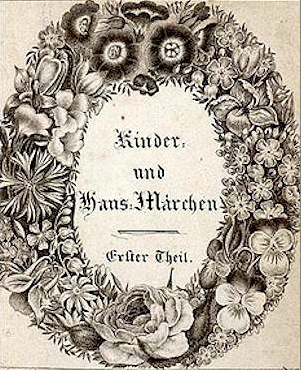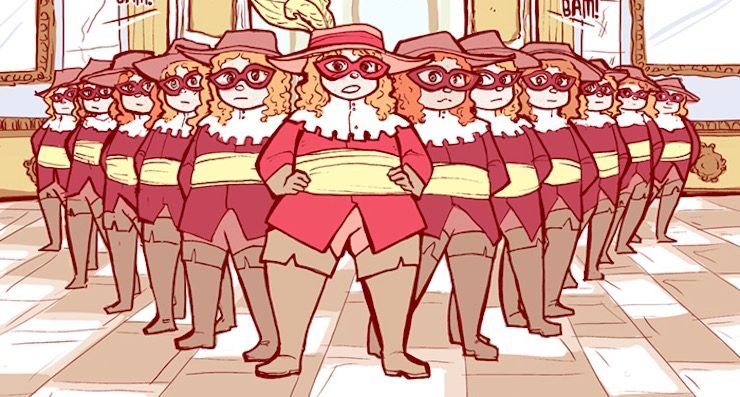Some English translations of Household Tales, aka The Fairy Tales of the Brothers Grimm, place “The Twelve Huntsmen” in the front. Some hide the tale in the center, and others omit the story altogether. Rather befitting a story that, although definitely collected by the Grimms, in many ways seems to be the complete antithesis of what they originally hoped to do with their fairy tale collection—both in the original edition, most definitely not edited or published with children in mind, and the later editions, which were.
Brothers Jacob and Wilhelm Grimm were born into a warm, loving middle class family in 1785 and 1786 respectively, in Hesse-Kassel, at the time part of the Holy Roman Empire. Their initially prosperous, happy lives were disrupted by two different events: the unexpectedly early death of their father in 1796, which came close to bankrupting the family, and the Napoleonic Wars.
Fortunately for the boys, their mother had aristocratic connections, just enough to get her sons enrolled in a school generally restricted to the upper classes. The boys found their comparative lack of funds distressing, but still managed to graduate at the heads of their respective classes—just enough, with those aristocratic connections, to let them study law at a school that otherwise would have rejected them thanks to their social standing.
By this time, they both faced the other major disruption in their lives: the Napoleonic Wars. The war did provide Jacob, at least, with a much needed job used to support the family (he and Wilhelm had four younger siblings.) By 1808, Jacob even found himself working as a librarian for Napoleon’s brother, Jerome Bonaparte, who had been named King of Westphalia. That experience hardly softened his feelings about France and tyranny; indeed, as the wars continued, both Jacob and Wilhelm found themselves increasingly interested in (limited) democracy, German culture, and German reunification, themes that led them to start collecting and recording oral, that is, “true” German tales, as examples of “true” German culture, editing the stories for clarity and smoothness, adding the occasional literary touch.
I have “true” in quote marks because, as discussed in the Disney Read-Watch, many of these fairy tales were originally French or Italian. Indeed, in some cases, in an impressive display of memorization, the German versions matched the French stories nearly word for word, or merely eliminated a fairy or two, though in other cases, the German versions had different endings, or different beginnings, or both. In either case, in the opinions of the Grimms, the stories needed to reflect “German” values and folklore; thus, things like “fairies” (very French) were changed into “witches” (a little less French) when, that is, they weren’t left out altogether.
To add to the problems, these literary French and Italian tales had generally not been published with children in mind, and many of the more “German” stories also dealt with decidedly adult themes. When reports came in of once innocent children actually reading these shocking tales, the Grimms decided they needed to do even more editing. And they did. Subsequent editions not only eliminated several elements considered inappropriate for children, but also edited the tales to include proper moral lessons that would reinforce the very best elements of the German character and, of course, proper gender roles, including the values of modesty, obedience and honesty for young girls.

Which is why it’s so odd to see “The Twelve Huntsmen” smack dab in the beginning, middle or end of this collection.
“The Twelve Huntsmen” starts right where many fairy tales end, with a prince and princess in love, planning their wedding. This happy event is cancelled by the sudden death of the king’s father, who, on his deathbed, requests his son to marry another bride. The heartbroken son agrees, immediately forgetting his first love.
At this point, his first love has several options, all well documented in history books: (1) drown her sorrows in a vat of French—no, wait, this is a Grimm story, German wine, (2) realize that she’s much better off without the loser, (3) marry someone else, (4) hire an assassin to kill the guy, (5) breed horses, (6) enter a convent, (7) write poems. Instead, the princess tries an approach not used by quite as many historical princesses: infiltrate the home of her former flame dressed as a man, accompanied by eleven identical looking young woman, all also dressed as men.
At this point, some of you might be thinking that as a revenge strategy, this is all just a touch overdone, and that maybe—just maybe—the princess would be better off going back to option one. Or option four. The rest of you are probably trying to figure out the logistics of this—just how did this princess find eleven women who looked exactly like her? Was she just counting on the hope that everyone she encountered would be near sighted but not have glasses? (A not unlikely hope even in the 18th and 19th century, after corrective lenses became increasingly common among the middle and upper classes.) Not to mention wondering just what the eleven other women thought about this? A chance to get this unstable princess out of their own country and thus someone else’s problem—a problem that specifically would not harm their own families? Or just a potential paycheck?
Since “The Twelve Huntsmen” is not particularly interested in explaining any of this, the story instead rushes to the next bit, the arrival of the women to the castle of the unfaithful prince, who agrees to hire them as huntsmen on the basis that they are hot. Yes, really, that’s his motivation. Seriously, princess, you can do better. Suddenly, a lion enters the story, complaining that the huntsmen are women, not men. The unfaithful prince—now a king—is dubious, but agrees to go along with various tests the lion insists will prove that the huntsmen are secretly women. Things like stepping on peas, because of course the women won’t be able to step firmly on peas, or walking past spinning wheels because apparently every single woman the lion has ever met has been all SPINNING WHEELS ARE MY SECRET FETISH, LION. I CANNOT RESIST THEM. This lion likes to stereotype people, is all I’m saying.
Warned in advance, the huntsmen successfully stomp on peas and suppress all of their deepest feelings about spinning wheels. The king finds himself doing a lot of hunting, until, that is, the princess hears news about his other betrothed—remember her? It’s ok if not, since the story mostly doesn’t—and romantically faints dead at his feet. YAY, because being unconscious is apparently the king’s thing—a thing, to be fair, that he seems to share with an alarming number of fairy tale princes—and a few sentences later, they’re married.
Be still my little heart.
Which is to say, we have here:
- One lion who really needs to get out more and meet women who aren’t just interested in peas and spinning wheels.
- One king who is apparently not feeding his staff all that well given how easily they pass out.
- One woman outright rewarded for entering—and succeeding at—a male profession, even if her plan, such as it isn’t, only works after she faints.
- And any number of questions, starting, but not ending, with, uh, if this king can only recognize this princess when she’s passed out cold, what exactly were they doing together before this story got started? What sort of a king doesn’t find the sudden appearance of twelve identical looking men at least slightly suspicious? Why isn’t this lion looking for a better king? Did the king ever happen to tell the girl, ‘hey, so, I’ve got this magical talking lion at home who has Ideas about women, just so you know’? And why, exactly, is a woman who has clearly embraced some non-traditional roles here allowing this lion to stay around after all of this?
Also, where, exactly, is the other bride during all of this?
I ask, since up to her complete failure to appear in this story, “The Twelve Huntsmen” is, in its way, a nearly classic “false bride” tale, like “The Goose Girl” or “The Singing, Springing Lark,” two other tales collected by the Grimms. That is, a tale where the girl must disguise herself as some sort of servant or beggar in order to win her husband from a rival—often a fiercely ugly one. I say “nearly classic,” since in these false bride tales, the girl is generally alone, and nearly always in a dress, even when in rags. Sometimes she works out a trade with the false bride, for a single night beside her sleeping prince—a trade that usually, but not always, includes magical items. Usually, the false bride dies a painful death, or flees.
In this story, she just doesn’t show up, making her arguably the most sensible character in this entire saga.
I say “nearly classic” for another reason. In many false bride tales—including “The Goose Girl” and “The Singing, Springing Lark”—the girl receives some magical assistance or aid, either from a horse that won’t stop talking even after he’s dead (enough, horse!), or from witches, or the sun and the moon and the stars, or the East and West winds. Here the princess receives assistance only from very human sources: her father, who helps her find the eleven identical women; the women; and the servant who warns the huntsmen about the upcoming gender tests. She and the huntsmen beat the tests not through magic, or trading magical items, but by defying the stereotypes of their gender: walking firmly on peas and ignoring spinning wheels.
The twelve huntsmen are hardly the only cross-dressers to appear in western fairy tales—it’s very nearly a motif, especially for tellers who, for one reason or another, wanted to explore issues of gender or restrictions placed on women, particularly aristocratic women, or just wanted to play with the idea of a girl pretending to a boy. Many of these tales were deliberately subversive, or featured kings, queens and princes who were at best indifferent or careless rulers, at worst rulers who failed to defend their kingdoms from monsters and war, or found themselves thrown from their thrones. Against those kings, these tales hint, refusing to conform to gender roles could be not just necessary, but heroic.
In this context, having a group of twelve gender-defying women refuse to follow the stereotyped expectations of talking lions show up in the middle of Household Tales makes considerable sense. The Grimm brothers, after all, had witnessed more than their fair share of questionable rulers, both German and French, and hoped that the 19th century would usher in limited democracy for the German states. (Not universal voting, of course. They were not that liberal.) And they knew their fairy tales, and knew that transformation, change and disguise is at the heart of many folktales. Something like this was bound to sneak in at some point. Even into a book whose other tales urged women to remain obedient, chaste, modest, and skilled at work associated with women. Not hunting.
I bring up this tale partly because it embodies the sheer glorious weirdness of so many old fairy tales, but also because it shows the sheer power of fairy tales, where even a tale edited for morality and conformity can still hold more than a hint of fairy rebellion.
Something we’ll be seeing in further posts.
Top image: Comic adaptation of “The Twelve Huntsmen” by Elle Skinner.
Mari Ness lives in central Florida.










